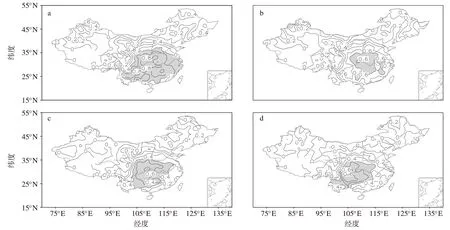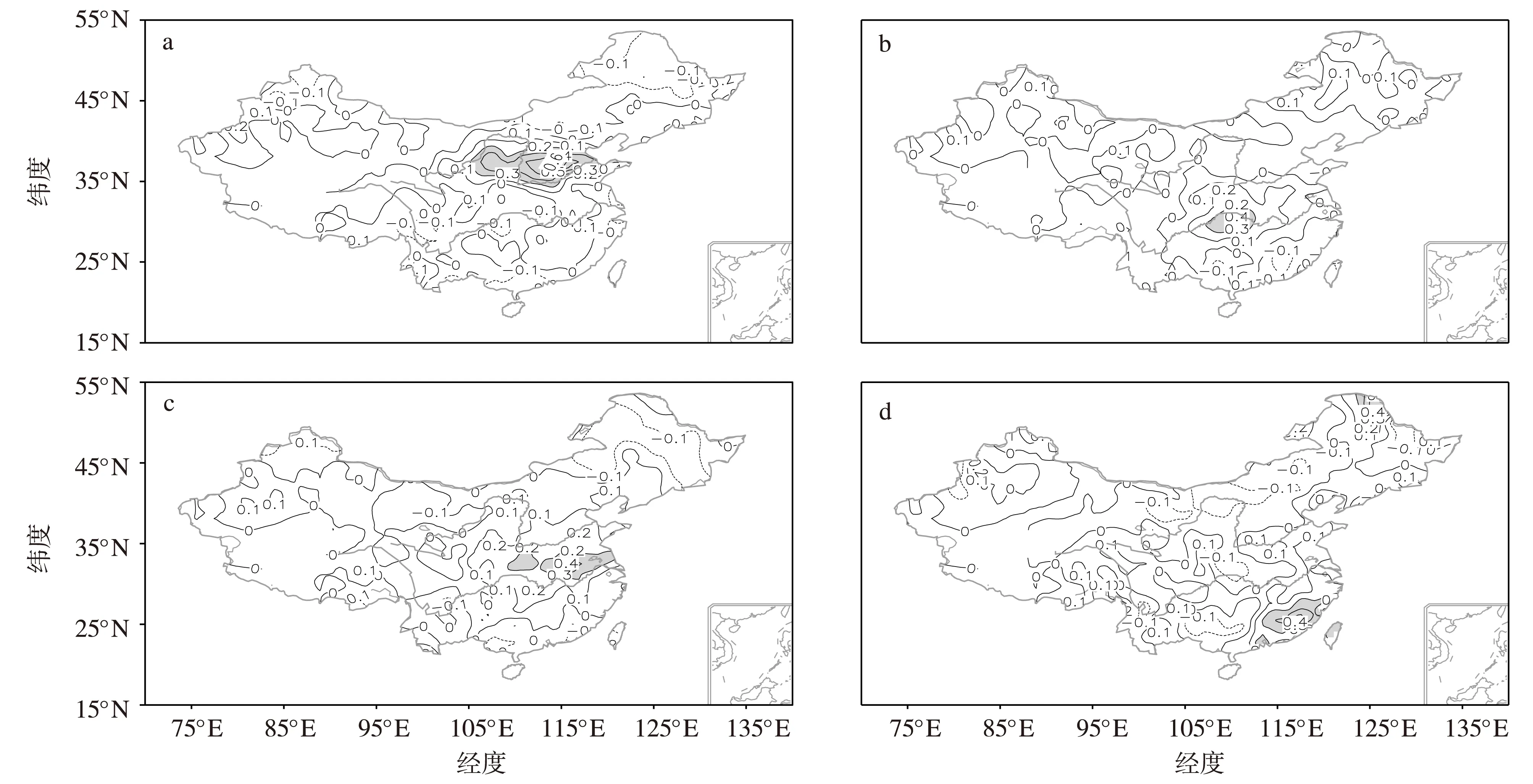我国秋季连阴雨的气候特征及大气环流特征
2016-08-11孙照渤黄艳艳倪东鸿
孙照渤,黄艳艳,倪东鸿
南京信息工程大学 气象灾害教育部重点实验室/气候与环境变化国际合作联合实验室/气象灾害预报预警与评估协同创新中心,江苏 南京 210044
我国秋季连阴雨的气候特征及大气环流特征
孙照渤*,黄艳艳,倪东鸿
南京信息工程大学 气象灾害教育部重点实验室/气候与环境变化国际合作联合实验室/气象灾害预报预警与评估协同创新中心,江苏 南京 210044
2014-04-13收稿,2014-05-14接受
公益性行业(气象)科研专项(GYHY201306028);国家自然科学基金资助项目(41075070);国家重点基础研究发展计划(973计划)项目(2013CB430202);江苏省自然科学基金资助项目(BK20131431);江苏高校优势学科建设工程资助项目(PAPD)
摘要采用1961—2010年全国753站逐日降水资料,给出了我国秋季连阴雨的定义,分析我国秋季连阴雨和不同级别(5~7 d、8~10 d和11 d及以上)秋季连阴雨的气候特征;将我国秋季连阴雨划分为华北、西南、江淮和华南地区4区,并分析华北地区秋季连阴雨期间和不同级别秋季连阴雨期间的大气环流特征。结果表明:1)我国秋季连阴雨及不同级别秋季连阴雨50 a累计频次在长江中上游地区较大,黄河以北地区较小;随着连阴雨级别的增加,连阴雨频次大值区由东南地区移向西南地区;频次标准差与频次的分布特征类似。2)华北地区连阴雨及不同级别连阴雨期间,巴尔喀什湖与贝加尔湖间的阻塞高压增强,850 hPa上增强的偏北和偏南气流交汇于华北地区,500 hPa上东亚大槽槽后偏北气流引导北方冷空气南下,副热带高压西侧偏南气流引导南方暖空气北上,冷、暖空气在华北地区交汇,易形成连阴雨天气。
关键词
秋季连阴雨
气候特征
大气环流
连阴雨是我国常见的气象灾害之一,给工农业生产、交通运输及人们日常生活等带来诸多不便。在不同的季节,连阴雨的影响是不同的,如:秋季连阴雨影响秋田作物的收获、贮藏以及冬小麦的播种等(方建刚等,2005;魏锋等,2005;韩荣青等,2009;于凤英等,2009;张立波等,2013)。因此,研究我国秋季连阴雨的气候特征及其成因有着重要的实际应用价值,可以为政府部门决策服务工作提供重要依据。
许多学者对连阴雨进行了深入研究(武鸣气象站,1966;赵文兰,1980;Jing et al.,2010;李辉和董彬,2012)。赵树华(1982)、刘文亮(1984)、王健元和孔瑞芝(1994)、赵玲和李树岭(1996)的研究表明,秋季连阴雨是在大环流形势稳定情况下产生的。林纾和章克俭(2003)、马占良(2008)、于凤英等(2009)、刘慧敏等(2010)研究了局部地区秋季连阴雨的大气环流特征及水汽来源等,并建立连阴雨强度模型。王丹等(2014)指出,陕西秋季连阴雨呈南多北少的分布,该分布特征与秦岭山脉的地形作用有关。研究表明,部分地区连阴雨的年频次以及全国的降水量和降水日数均呈减小趋势(Zhai et al.,1999;邹旭恺等,2005;冯建民等,2011;李聪,2012)。李辉和董彬(2012)的研究表明,河南周口秋季连阴雨在20世纪70、80年代较多,90年代以来多为10 d以上的长连阴雨。陈丽芳和陈勇明(2011)研究认为,长江中下游秋季出现强连阴雨过程的典型环流形势是欧亚地区500 hPa呈“两槽一脊”型。方建刚等(2005)认为,2003年陕西秋季连阴雨的环流条件为500 hPa欧亚环流形势相对稳定。
上述分析表明,部分地区秋季连阴雨的特征、形成机制及其与天气系统的关系已得到大量研究,人们对秋季连阴雨有较深入的认识。然而,上述研究大多基于局部区域或全年时间的范畴,有关多年全国秋季连阴雨的系统研究还较少见。连阴雨的危害主要在于其降水持续时间长,易使农作物霉烂,给人们日常生活和工农业生产等带来不利影响。为有效避免秋季连阴雨带来的损失,有必要对秋季连阴雨的气候特征及其成因进行分析。在不同地区,秋季连阴雨的标准并不一样,就全国范围内的秋季连阴雨而言,是否存在统一的划分标准?各级别秋季连阴雨的气候特征如何?秋季连阴雨期间的环流特征又如何?针对上述问题,本文拟采用1961—2010年秋季(9—11月)中国753站逐日降水和日照资料以及1948—2010年NCEP/NCAR再分析资料的逐日高度场、风场(垂直方向为17层,分辨率为2.5°×2.5°)和海平面气压场(分辨率为2.5°×2.5°)资料进行深入探讨。
1 我国秋季连阴雨标准
查阅书籍和文献发现,在全国范围内秋季连阴雨的定义标准不一致。一般需要考虑日降水量、连续降水日数和过程降水量,有时甚至需要考虑日照条件。在某些地区,因其特殊的地形地貌,对连阴雨的定义需加入一些特殊的要求。如:赵树华(1982)研究山东潍坊秋季连阴雨、姜爱军等(1997)研究江苏省连阴雨时,在连阴雨定义中加入了日照时数的限制;邹旭恺等(2005)研究长江三峡库区连阴雨时,允许连阴雨过程降水中可有不连续无降水日的存在;魏锋等(2005)研究甘肃省连阴雨、王丹等(2014)研究陕西秋季连阴雨时,在连阴雨定义中加入了云量的限制。
本文在前人研究的基础上,综合各地区特殊的地理环境和气候特征,对我国秋季连阴雨的标准进行了反复的修正、尝试,试图制定出能够充分反映我国秋季连阴雨特征的标准。最终,本文对我国秋季连阴雨的标准规定如下:
1)一次连阴雨过程持续5 d及以上,包括微量降水。
2)秋季连阴雨过程降水量≥10 mm;秋季连阴雨过程降水量在当年秋季总降水量中所占比例≥20%。
3)连阴雨过程中日平均日照时数≤2 h。
4)当降水量为0时,连阴雨过程结束。
5)连阴雨分为3个级别,即5~7 d、8~10 d和11 d及以上;各级别连阴雨均为连续降水。
本文涉及到的我国秋季连阴雨是指5 d及以上的连阴雨;为弄清我国秋季连阴雨不同持续时间下的气候特征和环流特征有何异同,本文又将我国秋季连阴雨分为3个级别(5~7 d、8~10 d和11 d及以上)进行研究。
对1961—2010年秋季(9—11月)中国753站逐日降水和日照资料进行处理。在50 a中,当某站日缺测数据多于5 a时,则剔除该站全部数据;当日缺测数据不多于5 a时,则用其多年平均值替代缺测数据。这样共有565站符合要求。
2 我国不同级别秋季连阴雨的气候特征
2.1不同级别秋季连阴雨的分布特征
我国秋季连阴雨及不同级别秋季连阴雨50 a累计频次、过程降水量年平均值和50 a累计日数两两之间的相似系数均在0.9~1.0之间,说明它们的空间分布非常相似,同时连阴雨频次在一定程度上反映了连阴雨的明显程度(邹旭恺等,2005),因此本文主要对我国秋季连阴雨及不同级别秋季连阴雨的频次进行分析。
图1为我国秋季连阴雨及不同级别秋季连阴雨50 a累计频次的空间分布。图1a表明,5 d及以上连阴雨的50 a累计频次在长江中上游地区较大,超过50次,贵州等地可达60次。图1b表明,5~7 d连阴雨的50 a累计频次在中国东南部较大,武汉等地达28次。图1c表明,8~10 d连阴雨的50 a累计频次在中国中南部较大,贵州等地达21次。图1d表明,11 d及以上连阴雨的50 a累计频次在云贵地区较大,达40次。不同级别连阴雨的50 a累计频次在黄河以北地区均较小。此外,随着连阴雨级别的增加,连阴雨频次大值区由东南地区移向西南地区(图1b—d)。
2.2不同级别连阴雨标准差分布
图2为我国秋季连阴雨及不同级别秋季连阴雨频次的标准差分布。图2a表明,5 d及以上连阴雨频次标准差大值区主要位于黄河以南,湖北、贵州和江西等地连阴雨频次标准差较大,达0.8次。图2b表明,5~7 d连阴雨频次标准差大值区主要位于中国中南部,武汉等地达0.7次。图2c表明,8~10 d连阴雨频次标准差大值区主要中国中南部,贵州等地达0.6次。图2d表明,11 d及以上连阴雨频次标准差大值区主要位于云贵地区,达0.6次。不同级别连阴雨频次标准差在黄河以北地区均较小。此外,随着连阴雨级别的增加,连阴雨频次标准差大值区由东南地区移向西南地区(图2b—d)。

图1 1961—2010年我国秋季(9—11月)连阴雨及不同级别秋季连阴雨的50 a累计频次分布(单位:次;a,b,c,d等值线间隔分别为10、4、3、5次,阴影区分别表示大于40、16、12、25次) a.5 d及以上;b.5~7 d;c.8~10 d;d.11 d及以上Fig.1 Distribution of the accumulated frequency of continuous autumn(September—November) rain and continuous autumn rain of different levels in China from 1961 to 2010;(a)5 d and above;(b)5—7 d;(c)8—10 d;(d)11 d and above[frequency intervals for (a—d) are 10,4,3 and 5,respectively;shading denotes frequencies greater than 40,16,12 and 25,respectively]

图2 1961—2010年我国秋季(9—11月)连阴雨及不同级别连阴雨频次的标准差分布(单位:次;等值线间隔:0.1次;a,b,c,d阴影区分别表示大于0.6、0.6、0.4、0.4次) a.5 d及以上;b.5~7 d;c.8~10 d;d.11 d及以上Fig.2 Standard deviation distribution of the accumulated frequency of continuous autumn(September—November) rain and continuous autumn rain of different levels in China from 1961 to 2010:(a)5 d and above;(b)5—7 d;(c)8—10 d;(d)11 d and above[frequency interval for (a—d) is 0.1;shading denotes standard deviation of frequencies greater than 0.6,0.6,0.4 and 0.4,respectively]
3 我国秋季连阴雨的区域特征及其环流特征
3.1区域划分
普查1961—2010年我国秋季连阴雨多发区域,将我国秋季连阴雨划分为4个区域,然后对该4区域的具体覆盖范围进行选择,过程如下:选取每个区域中连阴雨频次标准差最大值所在站作为该区域的代表站,将其与全国565站连阴雨频次进行相关分析,根据相关系数值检验代表站的代表性;若该站不具有代表性,则选取连阴雨频次标准差次大值为代表站,进行分析和检验,并以此类推,直到选取出合适的代表站,在此基础上进一步确定各区域的具体地理位置。
最终确定的4区域为华北地区(62站)、西南地区(113站)、江淮地区(38站)和华南地区(97站),各区的代表站依次为河北邢台、湖北五峰、河南固始和福建永安,各代表站与全国565站连阴雨频次的相关分布见图3。可见,我国秋季连阴雨的区域性很明显,对其作分区研究是非常必要的。

图3 华北地区(a)、西南地区(b)、江淮地区(c)和华南地区(d)代表站与全国565站连阴雨频次的相关系数分布(阴影区表示通过0.1信度的显著性检验)Fig.3 Correlation coefficients of the frequency of continuous autumn rain of representative stations of (a)North China,(b)Southwest China,(c)the Changjiang—Huaihe basin,and (d)South China,with 565 stations in China(shading denotes coefficients significant at the 90% confidence level)
受我国特殊地形地貌影响,在不同区域,形成秋季连阴雨的环流形势是不同的,受篇幅所限,本文仅对华北地区秋季连阴雨及不同级别秋季连阴雨的环流特征进行深入探讨,而西南地区、江淮地区和华南地区的情况则另文讨论。
3.2华北地区连阴雨过程的选取
普查华北地区62站(图4)逐年连阴雨情况。规定:当发生连阴雨的站数占该区域总站数的1/3及以上时,记为该地区的一次连阴雨过程。以此标准对华北地区秋季连阴雨及不同级别秋季连阴雨过程进行筛选,得到的连阴雨过程见表1。可知,1961—2010年华北地区5 d及以上的连阴雨过程有32次;5~7 d的有11次;8~10 d的有3次;11 d及以上的有2次。5 d及以上和5~7 d连阴雨多发生在9月,10月次之,11月最少。

图4 华北地区62站的地理分布Fig.4 Geographical distribution of 62 stations in North China
3.3华北地区秋季连阴雨期间的环流特征
为了研究华北地区秋季连阴雨及不同级别秋季连阴雨期间的环流形势,对筛选出的秋季连阴雨及不同级别秋季连阴雨期间的高度场、风场和海平面气压场以及它们的距平场进行合成分析。
3.3.1500 hPa高度场
图5为华北地区秋季连阴雨及不同级别秋季连阴雨期间合成的500 hPa高度场及其距平场。图5a表明,5 d及以上连阴雨期间,在500 hPa高度场上,东亚大槽较深,乌拉尔山长波脊较强,巴尔喀什湖低槽较明显,华北地区处于东亚大槽槽后,槽后偏北气流引导北方冷空气南下,此时副热带高压较强,位置偏北,其西侧偏南气流引导南方暖湿空气北上,与来自北方的冷空气交汇于华北地区,易形成连阴雨天气。图5b也表明,华北地区受高度正距平控制,其西为高度负距平,鄂霍次克海为高度负距平,乌拉尔山为高度正距平,中心强度达90 gpm。
图5c、e、g表明,不同级别连阴雨期间,在500 hPa高度场上,东亚大槽槽后偏北气流引导北方冷空气南下,副热带高压西侧偏南气流引导南方暖空气北上,冷、暖空气在华北地区交汇,易形成连阴雨天气。图5d、f、h也表明,华北地区受高度正距平控制,其东侧和西侧均为高度负距平。但是,华北地区不同级别连阴雨期间的环流形势并不完全一样,具体表现为:东亚大槽和乌拉尔山高脊均以8~10 d的为最强,位置偏东,11 d及以上的次之,5~7 d的最弱;巴尔喀什湖低槽以8~10 d的为最明显。
3.3.2850 hPa风场
图6为华北地区秋季连阴雨及不同级别秋季连阴雨期间合成的850 hPa风场及其距平场。图6a表明,5 d及以上连阴雨期间,华北地区有来自西太平洋、南海和孟加拉湾的偏南气流,高纬地区平直西风带气流在贝加尔湖一带转为偏北气流南下,与来自南方的气流在我国华北地区交汇,易形成连阴雨天气。图6b也表明,异常南风和异常北风交汇于华北地区。
图6c、e、g表明,不同级别秋季连阴雨期间,偏北气流和偏南气流在我国华北地区交汇;图6d、f、h表明,异常南风和异常北风交汇于华北地区。但是,不同级别连阴雨期间的风场特征有所不同,随着连阴雨级别的增加,交汇于华北地区的风速增加。
3.3.4海平面气压场
图7为华北地区秋季连阴雨及不同级别秋季连阴雨期间合成的海平面气压场及其距平场。可见:
表11961-2010年华北地区秋季连阴雨的起止日期及持续时间
Table 1Start dates,end dates and durations of continuous autumn rain in North China from 1961 to 2010

年份开始日期结束日期持续时间/d196110月15日10月19日519629月22日9月28日711月18日11月22日519639月15日9月20日6196711月22日11月29日8196810月5日10月12日819699月20日9月29日10197310月1日10月6日619749月9日9月14日69月29日10月3日519759月27日10月2日619799月12日9月16日5198310月11日10月20日1019849月6日9月11日69月22日9月29日85d及以上19859月8日9月18日1110月9日10月20日1219869月6日9月10日510月16日10月20日5198710月12日10月16日5198910月2日10月7日619929月11日9月22日12199311月6日11月11日6199410月14日10月18日519999月28日10月6日920039月1日9月7日79月26日9月30日520059月25日10月3日9200611月22日11月27日620079月26日10月1日620099月4日9月8日520109月5日9月10日619699月23日9月29日7197310月1日10月6日619749月9日9月14日619799月12日9月16日519849月6日9月11日65~7d19869月6日9月10日510月16日10月20日5199311月6日11月11日6199410月14日10月18日5200611月22日11月27日620099月4日9月8日5196810月5日10月12日88~10d198310月11日10月20日1020059月25日10月3日911d及以上19859月8日9月18日1110月9日10月20日12

图5 华北地区秋季连阴雨及不同级别秋季连阴雨期间合成的500 hPa高度场(a,c,e,g)及其距平场(b,d,f,h)(单位:gpm;a,c,e,g等值线间隔为50 gpm;b,d,f,h等值线间隔分别为10、20、20、30 gpm;阴影表示通过0.01信度的显著性检验) a,b.5 d及以上;c,d.5~7 d;e,f.8~10 d;g,h.11 d及以上Fig.5 Composite (a,c,e,g)height fields and their (b,d,f,h)anomaly fields at 500 hPa during continuous autumn rain and continuous autumn rain of different levels in North China:(a,b)5 d and above;(c,d)5—7 d;(e,f)8—10 d;(g,h)11 d and above[units:gpm;(a,c,e,g)with 50-gpm intervals;(b,d,f,h)with intervals of 10,20,20 and 30 gpm,respectively;shading denotes anomalies significant at the 99% confidence level]

图6 华北地区秋季连阴雨及不同级别秋季连阴雨期间合成的850 hPa风场(a,c,e,g)及其距平场(b,d,f,h)(单位:m·s-1)a,b.5 d及以上;c,d.5~7 d;e,f.8~10 d;g,h.11 d及以上Fig.6 Composite (a,c,e,g)wind fields and their (b,d,f,h)anomaly fields at 850 hPa during continuous autumn rain and continuous autumn rain of different levels in North China (units:m·s-1):(a,b)5 d and above;(c,d)5—7 d;(e,f)8—10 d;(g,h)11 d and above

图7 华北地区秋季连阴雨及不同级别秋季连阴雨期间合成的海平面气压场(a,c,e,g)及其距平场(b,d,f,h)(单位:hPa;a,c,e,g等值线间隔为4 hPa;b,d,f,h等值线间隔分别为1、1、1、2 hPa;阴影区表示通过0.01信度的显著性检验)a,b.5 d及以上;c,d.5~7 d;e,f.8~10 d;g,h.11 d及以上Fig.7 Composite (a,c,e,g)sea level pressure fields and their (b,d,f,h)anomaly fields at 500 hPa during continuous autumn rain and continuous autumn rain of different levels in North China:(a,b)5 d and above;(c,d)5—7 d;(e,f)8—10 d;(g,h)11 d and above[units:hPa;(a,c,e,g) with 4 hPa intervals;(b,d,f,h) with intervals of 1,1,1 and 2 hPa,respectively;shading denotes the anomalies significant at the 99% confidence level]
秋季连阴雨及不同级别秋季连阴雨期间合成的海平面气压及其距平场有着相似的特征,即:在巴尔喀什湖和贝加尔湖之间有一阻塞高压,华北地区处于该阻塞高压的外围;华北地区受气压正距平控制。但是,在不同级别连阴雨期间,该阻塞高压的强度不同;且该阻塞高压的增强程度也不同,11 d及以上的最大,5~7 d的次之,8~10 d的最小。
4 结论
本文给出了我国秋季连阴雨的定义,并对我国秋季连阴雨的气候特征及环流特征进行初步研究,得到以下结论:
1)我国秋季连阴雨及不同级别秋季连阴雨50 a累计频次在长江中上游地区较大,黄河以北地区较小。随着连阴雨级别的增加,连阴雨频次大值区由东南地区移向西南地区。秋季连阴雨及不同级别连阴雨频次标准差与频次的分布特征类似。
2)普查1961—2010年我国秋季连阴雨多发区域,将我国秋季连阴雨划分为华北地区、西南地区、江淮地区和华南地区,各区代表站依次为河北邢台、湖北五峰、河南固始和福建永安。
3)华北地区连阴雨及不同级别连阴雨期间,在500 hPa高度场上,东亚大槽槽后偏北气流引导北方冷空气南下,副热带高压西侧偏南气流引导南方暖空气北上,冷、暖空气在华北地区交汇,易形成连阴雨天气;华北地区受高度正距平控制,其东侧和西侧均为高度负距平;但是,不同级别连阴雨期间的环流形势并不完全一样,东亚大槽和乌拉尔山高脊均以8~10 d的为最强,位置偏东,11 d及以上的次之,5~7 d的最弱,巴尔喀什湖低槽以8~10 d的为最明显。在850 hPa风场上,偏北气流和偏南气流在华北地区交汇;异常南风和异常北风也交汇于华北地区;但是,不同级别连阴雨期间,风场特征有所不同,随着连阴雨级别的增加,交汇于华北地区的风速增加。在海平面气压场上,巴尔喀什湖和贝加尔湖之间有一阻塞高压,华北地区处于该阻塞高压的外围;华北地区受气压正距平控制;但是,在不同级别连阴雨期间,该阻塞高压的强度不同,且该阻塞高压的增强程度也不相同,11 d及以上的最大,5~7 d的次之,8~10 d的最小。
参考文献(References)

陈丽芳,陈勇明,2011.长江中下游两次罕见连阴雨强降水的对比分析[J].高原气象,30(2):397-405.Chen L F,Chen Y M,2011.Comparative analysis on two rare and continuous rainfall processes in mid-and lower-reaches of Yangtze River[J].Plateau Meteor,30(2):397-405.(in Chinese).
方建刚,白爱娟,陶建玲,等,2005.2003年陕西秋季连阴雨降水特点及环流条件分析[J].应用气象学报,16(4):509-517.Fang J G,Bai A J,Tao J L,et al.,2005.Analysisi of continous rainfall in Shaanxi in 2003 autumn with circulation features[J].J Appl Meteor Sci,16(4):509-517.(in Chinese).
冯建民,郑广芬,陈豫英,等,2011.宁夏连阴雨(雪)过程变化规律研究[J].中国沙漠,31(6):1590-1597.Feng J M,Zheng G F,Chen Y Y,et al.,2011.Study on processes of persistent rainy or snow events in Ningxia[J].Journal of Desert Research,31(6):1590-1597.(in Chinese).
韩荣青,陈丽娟,李维京,等,2009.2—5月我国低温连阴雨和南方冷害时空特征[J].应用气象学报,20(3):312-320.Han R Q,Chen L J,Li W J,et al.,2009.The spatial and temporal characteristics of China continuous cold rainy weather and south cold damage from February to May[J].J Appl Meteor Sci,20(3):312-320.(in Chinese).
姜爱军,田心如,王冰梅,1997.连阴雨灾害评估模型的研究[J].灾害学,12(2):49-54.Jiang A J,Tian X R,Wang B M,1997.Research on the model of continuous wet weather hazard assessment[J].Journal of Catastrophology,12(2):49-54.(in Chinese).
Jing A H,Zhang Z H,Kong F Z,et al.,2010.Climatic analysis of continuous rain in southwest of Shandong[J].Meteorological and Environmental Research,1(9):15-17.
李聪,肖子牛,张晓玲,2012.近60年中国不同区域降水的气候变化特征[J].气象,38(4):419-424.Li C,Xiao Z N,Zhang X L,2012.Climatic characteristics of precipitation in various regions of China for the past 60 years[J].Meteor Mon,38(4):419-424.(in Chinese).
李辉,董彬,2012.周口秋季连阴雨天气气候特征[J].安徽农业科学,40(28):13900-13902.Li H,Dong B,2012.Characteristics of autumn overcast and rainy weather in Zhoukou[J].J Anhui Agri Sci,40(28):13900-13902.(in Chinese).
林纾,章克俭,2003.西北地区中东部2000年与2001年秋季连阴雨分析[J].气象,29(2):34-38.Lin S,Zhang K J,2003.Analysis of continuous autumn rain in Northwest China in 2000 and 2001[J].Meteor Mon,29(2):34-38.(in Chinese).
刘慧敏,魏娜,万宏卫,2010.陕北一次秋季连阴雨过程的天气动力学分析[J].陕西气象,43(1):10-13.Liu H M,Wei N,Wan H W,2010.A synoptic and dynamic analysis of a continuous autumn rain process in Northern Shaanxi[J].Journal of Shaanxi Meteorology,43(1):10-13.(in Chinese).
刘文亮,1984.秋季连阴雨预报[J].山东气象,4(3):23-25.Liu W L,1984.Forecast of continuous rain in autumn[J].Journal of Shandong Meteorology,4(3):23-25.(in Chinese).
马占良,2008.青海省秋季连阴雨天气特征分析[J].青海科技,15(2):31-33.Ma Z L,2008.Analysis on synoptic features of continuous autumn rain in Qinghai province[J].Qinghai Science and Technology,15(2):31-33.(in Chinese).
王丹,高红燕,盛立芳,等,2014.1960年以来陕西秋季连阴雨天气的变化特征[J].自然灾害学报,23(1):191-201.Wang D,Gao H Y,Sheng L F,et al.,2014.Variation characteristics of persistent autumn rain in Shaanxi from 1960[J].Journal of Natural Disasters,23(1):191-201.(in Chinese).
王健元,孔瑞芝,1994.一次罕见的秋季连阴雨天气[J].气象,20(11):65.Wang J Y,Kong R Z,1994.An infrequent continuous rainy weather in autumn[J].Meteor Mon,20(11):65.(in Chinese).
魏锋,白虎志,孙秉强,2005.甘肃省近35年连阴雨天气气候特征分析[J].成都信息工程学院学报,20(4):479-482.Wei F,Bai H Z,Sun B Q,2005.Climate feature of steady raining during past 35 years in Gansu province[J].Journal of Chengdu University of Information Technology,20(4):479-482.(in Chinese).
武鸣气象站,1966.武鸣气象站天气预报基本工具和春播期低温阴雨的预报方法[J].气象学报,36(2):198-207.Wuming Meteorological Station,1966.Basic tools of weather forecast and forecast methods of cold rainy weather during spring sowing period at Wuming Meteorological Station[J].Acta Meteorologica Sinica,36(2):198-207.(in Chinese).
于凤英,常平,杨学斌,2009.鲁西北罕见的秋季连阴雨环流特征分析[J].气象,35(10):71-78.Yu F Y,Chang P,Yang X B,2009.Analysis of a rare continuous autumn rain in Northwest Shandong[J].Meteor Mon,35(10):71-78.(in Chinese).
Zhai P M,Sun A J,Ren F M,et al.,1999.Changes of climate extremes in China[J].Climatic Change,42(1):203-218.
张立波,景元书,娄伟平,等,2013.近50 a华东地区雨日及降水量的变化特征[J].大气科学学报,36(4):426-433.Zhang L B,Jing Y S,Lou W P,et al.,2013.Variability of rainy days and rainfall in East China in recent 50 years[J].Trans Atmos Sci,36(4):426-433.(in Chinese).
赵玲,李树岭,1996.北高南低形势与秋季连阴雨预报[J].黑龙江气象,13(1):35-37.Zhao L,Li S L,1996.Circulation pattern of higher in the north and lower in the south and forecast of continuous autumn rain[J].Heilongjiang Meteorology,13(1):35-37.(in Chinese).
赵树华,1982.潍坊地区秋季连阴雨的气候情况和预报[J].山东气象,2(3):20-22.Zhao S H,1982.Climatic situation and forecast of continuous autumn rain in Weifang area[J].Journal of Shandong Meteorology,2(3):20-22.(in Chinese).
赵文兰,1980.春播期中期天气过程的超长波、长波预报[J].气象,7(3):11-12.Zhao W L,1980.Forecast of the ultra-long and long waves in the medium-range weather processes during spring sowing period[J].Meteor Mon,7(3):11-12.(in Chinese).
邹旭恺,张强,叶殿秀,2005.长江三峡库区连阴雨的气候特征分析[J].灾害学,20(1):84-89.Zou X K,Zhang Q,Ye D X,2005.An analysis on the climatic characteristics of consecutive rainfall in the Three Gorges Area[J].Journal of Catastrophology,20(1):84-89.(in Chinese).
Continuous autumn rain is long in duration,meaning it can easily cause crop mold and other adverse effects relating to daily life and industrial and agricultural production.In order to mitigate such losses caused by continuous autumn rain,it is important to study in depth the climate characteristics of continuous autumn rain and its causes.The present study does this based on the daily rainfall and sunshine data of 753 meteorological stations in China in autumn(September—November) from 1961 to 2010,along with NCEP/NCAR reanalysis data for the period 1948—2010.After defining continuous autumn rain in China,its climate characteristics for different levels(5—7 d,8—10 d,and 11 d and above) are analyzed.Based on a general survey of regions where continuous autumn rain was found to happen often during 1961—2010,China is divided into four regions of continuous autumn rain;namely,North China,Southwest China,the Changjiang—Huaihe basin,and South China,where representative stations are Xingtai(Hebei Province),Wufeng(Hubei Province),Gushi(Henan Province) and Yongan (Fujian Province),respectively.The circulation characteristics of continuous autumn rain and continuous autumn rain of different levels in North China are also analyzed.The results show that:
(1)The accumulated frequency of continuous autumn rain and continuous autumn rain of different levels mainly concentrates in the mid-upper reaches of the Yangtze River during 1961—2010,and is very small in the areas north to the Yellow River.With an increase in the level of rain,the high-frequency areas move from southeast to southwest.The frequency standard deviation is similar to the frequency of continuous autumn rain and continuous autumn rain of different levels.
(2)During the continuous autumn rain and continuous autumn rain of different levels in North China,in the 500 hPa geopotential height field,the northern cold air is guided to the south by northerly flow after the East Asian trough,and southern warm air is guided to the north by southerly flow on the west side of the subtropical high.The cold and warm air masses meet over North China,which is beneficial to the formation of the continuous rain weather.Positive height anomalies are located over North China,but negative height anomalies are located in the east and west sides of North China.
(3)The circulation patterns feature a number of differences among the different levels of continuous autumn rain.The East Asian trough and Urals ridge are the strongest and located farthest east for the 8—10 d level,followed by the 11 d and above level,and finally the 5—7 d level.The trough is most obvious over Lake Balkhash for the 8—10 d level.
(4)In the 850-hPa wind field,the enhanced southern and northern air streams meet over North China,as do the anomalous southerlies and northerlies.However,the wind field features differ among the different levels of continuous autumn rain:with an increase in the level of continuous rain,the wind speed converging over North China increases.
(5)In the sea level pressure field,the blocking high between Lake Balkhash and Lake Baikal strengthens,and North China is located in the peripheral region of the blocking high.Positive sea level pressure anomalies are located over North China.However,among the different levels of continuous autumn rain,the blocking high strength shows some differences,as does the extent of the enhancement of the blocking high,which is maximum for the 11 d and above level,followed by the 5—7 d level,and is minimum for the 8—10 d level.
continuous autumn rain;climate characteristics;general circulation
(责任编辑:张福颖)
doi:10.13878/j.cnki.dqkxxb.20140413001
Climate and circulation characteristics of continuous autumn rain in China
SUN Zhaobo,HUANG Yanyan,NI Donghong
KeyLaboratoryofMeteorologicalDisaster,MinistryofEducation(KLME)/JointInternationalResearchLaboratoryofClimateandEnvironmentChange(ILCEC)/CollaborativeInnovationCenterontheForecastandEvaluationofMeteorologicalDisasters(CIC-FEMD),NanjingUniversityofInformationScience&Technology,Nanjing210044,China
引用格式:孙照渤,黄艳艳,倪东鸿,2016.我国秋季连阴雨的气候特征及大气环流特征[J].大气科学学报,39(4):480-489.
Sun Z B,Huang Y Y,Ni D H,2016.Climate and circulation characteristics of continuous autumn rain in China[J].Trans Atmos Sci,39(4):480-489.doi:10.13878/j.cnki.dqkxxb.20140413001.(in Chinese).
*联系人,E-mail:sunzb@nuist.edu.cn
